From Wikipedia, the free encyclopedia
Hayyim Selig Slonimski
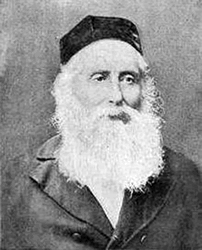
Hayyim Selig Slonimski
Born
March 31, 1810
Bialystok, Russian Empire (present-day Poland)
Died
May 15, 1904 (aged 94)
Warsaw, Kingdom of Poland
Resting place
Okopowa Street Jewish Cemetery
Notable works
Mosedei ?okmah, Sefer Kukba di-Shebit, Toledot ha-Shamayim
Notable awards
Demidov Prize (1844)
Spouse
Reiza Rivhas Neches
( m. 1828; div. 1836)
Sara Gitel Stern
( m. 1842; died 1897)
Relatives
Antoni S?onimski (grandson), Mikhail Slonimsky (grandson),[1] Nicolas Slonimsky (grandson)[2]
?ayyim Selig ben Ya'akov Slonimski (March 31, 1810 – May 15, 1904), also known by his acronym ?aZaS (????), was a Hebrew publisher, mathematician, astronomer, inventor, science writer, and rabbi. He was among the first to write books on science for a broad Jewish audience, and was the founder of Ha-Tsfira, the first Hebrew-language newspaper with an emphasis on the sciences.[3][4]
Biography
?ayyim Selig Slonimski was born in Bialystok, in the Grodno Governorate of the Russian Empire (present-day Poland), the oldest son of Rabbi Avraham Ya'akov Bishka and Leah (Neches) Bishka.[5] His father belonged to a family of rabbis, writers, publishers and printers, and his mother was the daughter of Rabbi Ye?iel Neches, an owner of a well-known beit midrash in Bialystok.[6] Slonimski had a traditional Jewish upbringing and Talmudic education; without a formal secular education, Slonimski taught himself mathematics, astronomy, and foreign languages.[7]
An advocate for the education of Eastern European Jews in the sciences, Slonimski introduced a vocabulary of technical terms created partly by himself into the Hebrew language. At age 24, he finished writing a textbook on mathematics, but due to lack of funds, only the first part of which was published in 1834 under the title Mosedei ?okhmah.[8]:?180? The following year, Slonimski released Sefer Kokhva de-Shavit (1835), a collection of essays on Halley's comet and other astronomy-related topics such as the laws of Kepler and Newton's laws of motion.[8]:?180?
In 1838, Slonimski settled in Warsaw, where he became acquainted with mathematician and inventor Abraham Stern (1768–1842), whose youngest daughter Sarah Gitel he would later marry in 1842. There he published another astronomical work, the highly popular Toldot ha-Shamayim (1838).[9]
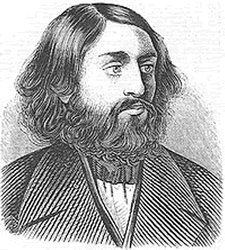
Slonimski in the 1840s
He also tried his hand at the applied sciences, and a number of his technological inventions received recognition and awards.[10] The most notable of his inventions was his calculating machine, created in 1842 based on his tables, which he exhibited to the St. Petersburg Academy of Sciences, and for which he was awarded the 1844 Demidov Prize of 2,500 rubles by the Russian Academy of Sciences.[11][12] He also received a title of honorary citizen, which granted him the right to live outside of the Pale of Settlement to which Jews were normally restricted.[13] In 1844, he published a new formula in Crelle's Journal for calculating the Jewish calendar.[14][15] In 1853 he invented a chemical process for plating iron vessels with lead to prevent corrosion, and in 1856 a device for simultaneously sending multiple telegrams using just one telegraphic wire. The system of multiple telegraphy perfected by Lord Kelvin in 1858 was based on Slonimski's discovery.[16]
Slonimski lived between 1846 and 1858 in Tomaszów Mazowiecki, an industrial town in central Poland. He corresponded with several scientists, notably Alexander von Humboldt, and wrote a sketch of Humboldt's life.
In February 1862 in Warsaw, Slonimski launched Ha-Tsfira, the first Hebrew newspaper in Poland, and was the publisher, editor, and chief contributor. It ceased publication after six months due to his departure on the eve of the January Uprising from Warsaw to Zhitomir, the capital of the Ukrainian province Volhynia.[17]:?6? There Slonimski was appointed as principal of the rabbinical seminary in Zhitomir and as government censor of Hebrew books. After the seminary was closed by the Russian government in 1874, Slonimski resumed the publication of Ha-Tsfira, first in Berlin and then again in Warsaw, after he obtained the necessary permission from the tsarist government.[18] The newspaper would quickly become a central cultural institution of Polish Jewry.[10]
He died in Warsaw on May 15, 1904.
The Stalin controversy[\
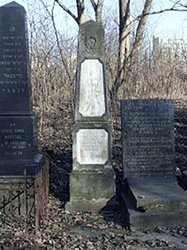
Slonimski's grave at Warsaw Jewish Cemetery
In 1952, Josef Stalin made a speech in which, among other things, he claimed that it was a Russian who had beat out America in the 19th century in the development of the telegraph.[19] While Stalin's claim was mocked in the United States, Slonimsky's grandson, the musicologist Nicolas Slonimsky, was able to confirm the accuracy of some of Stalin's claims.[20]
Major work[
• Mosede ?okmah (1834), on the fundamental principles of higher algebra
• Sefer Kukba di-Shebit (1835), essays on the Halley comet and on astronomy in general
• Toledot ha-Shamayim (1838), on astronomy and optics
• Yesode ha-'Ibbur (1852), on the Jewish calendar system and its history
• Me?i'ut ha-Nefesh ve-?iyyumah (1852), on the immortality of the soul
• Ot Zikkaron (1858), a biographical sketch of Alexander von Humboldt
See also[edit]
• Slonimski's Theorem
References[edit]
• This article incorporates text from a publication now in the public domain: Isidore Singer and Judah David Eisenstein (1901–1906). "Slonimski, ?ayyim Selig". In Singer, Isidore; et al. (eds.). The Jewish Encyclopedia. New York: Funk & Wagnalls.
Footnotes[edit]
1 ^ Slutsky, Yehuda (2007). "Slonimski, ?ayyim Selig". In Berenbaum, Michael; Skolnik, Fred (eds.). Encyclopaedia Judaica (2nd ed.). Detroit: Macmillan Reference. ISBN 978-0-02-866097-4.
2 ^ Slonimsky, Nicolas (1988). Perfect Pitch: A Life Story. Oxford: Oxford University Press. p. 14. ISBN 978-0193151550.
3 ^ Silberschlag, Eisig S. (1973). From Renaissance to Renaissance: Hebrew Literature from 1492–1970. New York: KTAV Publishing House. p. 177. ISBN 0870681842. OCLC 754267.
4 ^ Corry, Leo (2018). "Creating a Modern Hebrew Language for Mathematics" (PDF). In Movshovitz-Hadar, Nitsa (ed.). K–12 Mathematics Education in Israel: Issues and Innovations. Series on Mathematics Education. 13. Singapore: World Scientific. p. 319. ISBN 978-9813231184. LCCN 2017046285.
5 ^ Licht, Zerachya (10 December 2017). "Chaim Zelig Slonimsky and the Diskin family". The Seforim Blog (in Hebrew).
6 ^ Dalakov, Georgi. "Biography of Chaim Zelig Slonimski". History of Computers. Retrieved 19 August 2018.
7 ^ Monnier, Valéry; Szrek, Walter; Zalewski, Janusz (2013), "Chaim Selig Slonimski and his adding devices" (PDF), IEEE Annals of the History of Computing, 35 (3): 42–53, doi:10.1109/MAHC.2013.13, MR 3111378, S2CID 14843602
8 ^ Jump up to:a b Zinberg, Israel (1978). The Haskalah Movement in Russia. A History of Jewish Literature. 11. Translated by Martin, Bernard. New York: KTAV Publishing House. ISBN 0-87068-492-2.
9 ^ Robinson, Ira (1995). "Hayyim Selig Slonimski and the Diffusion of Science Among Russian Jewry in the Nineteenth Century". In Rabkin, Yakov M.; Robinson, Ira (eds.). The Interaction of Scientific and Jewish Cultures in Modern Times. Lewiston, N.Y. pp. 31–48.
10 ^ Jump up to:a b Feiner, Shmuel. "S?onimski, ?ayim Zelig". The YIVO Encyclopedia of Jews in Eastern Europe. Translated by Fachler, David.
11 ^ Aronson, Chaim (1983). Marsden, Norman (ed.). A Jewish Life Under the Tsars: The Autobiography of Chaim Aronson, 1825–1888. Oxford Centre for Postgraduate Hebrew Studies. p. 310. ISBN 978-0865980662.
12 ^ Szatkowski, Rick; Firtell, Ryan; Quee, Richard Chin (2006). "Chaim Zelig Slonimski". Polish Contributions to Computing. Retrieved 20 August 2018.
13 ^ Lilienthal, Max (1847). "Chajim Selig Slonimski, the Mathematician". Sketches of Jewish Life in Russia. V.
14 ^ Slonimsky, Chaim Zelig (1844). "Eine allgemeineformel fur die gesammte judische Kalenderberechnung". Journal für die reine und angewandte Mathematik (in German). 28: 179.
15 ^ Schamroth, J. (1998). A Glimpse of Light: A Discussion on the Hebrew Calendar. Feldheim. pp. 140–143.
16 ^ ? Singer, Isidore; Eisenstein, Judah David (1901–1906). "Slonimski, ?ayyim Selig". In Singer, Isidore; et al. (eds.). The Jewish Encyclopedia. New York: Funk & Wagnalls.
17 ^ Sneh, Itai (September 1991). Hayim Zelig Slonimski and the founding of ha-Tsefirah: the early career of an East European Jewish enlightener and popularizer of science, 1810-1862 (M.A. thesis). McGill University.
18 ^ Blutinger, Jeffrey C. (Winter 2010). "Creatures from Before the Flood: Reconciling Science and Genesis in the Pages of a Nineteenth-Century Hebrew Newspaper". Jewish Social Studies. 16 (2): 69. doi:10.2979/jss.2010.16.2.67. JSTOR 10.2979/jss.2010.16.2.67. S2CID 161515924.
19 ^ Green, David B. (15 May 2015). "This Day in Jewish History 1904: A Rabbi, Astronomer and Inventor Honored by Russia Dies". Haaretz.
20 ^ Slonimsky, Nicolas (1 January 1977). "My Grandfather Invented the Telegraph". Commentary. Retrieved 19 August 2018.
Wikimedia Commons has media related to Hayyim Selig Slonimski.
• Works by or about Hayyim Selig Slonimski at Internet Archive
Ludwig Slonimsky
From Wikipedia, the free encyclopedia
Ludwig Slonimsky
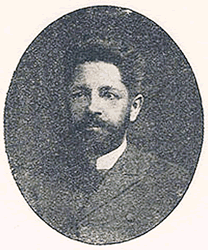
Born
Leonid Ludwik S?onimski
Leonid Ludwik S?onimski
1 November 1849
Warsaw, Poland (then part of Russian Empire)
Died
1918
Petrograd, Soviet Russia
Occupation
journalist, lawyer, editor
Ludwig Zinovievich Slonimsky (Polish: Leonid Ludwik S?onimski, 1 November 1849[1] —1918) was a Warsaw-born Jewish Russian journalist, publicist, economist and lawyer, the son of Hebrew scientist and publisher Hayyim Selig Slonimski.[2]
Career[edit]
A Kiev University alumnus, Slonimsky started publishing articles on law and jurisprudence in Sudebny Vestnik (Court Herald) in Saint Petersburg in 1872. From 1875 to 1879 he was the head of the Foreign Policy section in Russkiy Mir, and for some time co-edited it with Yevgeny Rapp. After a short stint with the Slovo magazine, in 1881 he joined the newspaper Poryadok (Order), then succeeded Valentin Korsh as its Foreign Policies editor. In late 1882 Slonimsky became a member of the Severny Vestnik staff where his essays on economics soon started to appear regularly; in 1883 he became the head of this magazine's Foreign Review section.[2]
Slonimsky lectured at the St Petersburg Juridical Society. He criticized Russia's financial policy, Marxist economics, and opposed the narodniks, while supporting obshchina. Among the issues he returned regularly to, were the theory of progress, usury, the rights of mentally ill patients, the legal rights of Jews in Russia and Leo Tolstoy's philosophy. He published numerous historical essays too, including those on Napoleon I, Oliver Cromwell, Alexander I and Nicholas I. Later in his life he co-edited (with Viktor Fausek) the Brockhaus and Efron Encyclopedic Dictionary.[2]
--
Gordin Levita
Nicolas Slonimsky
From Wikipedia, the free encyclopedia
For other people with the same last name, see Slonimsky.
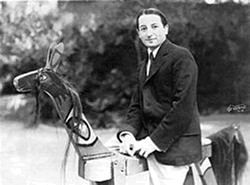
Nicolas Slonimsky in 1933.
Nicolas Slonimsky (April 27 [O.S. April 15] 1894 – December 25, 1995), born Nikolai Leonidovich Slonimskiy, was a Russian-born American conductor, author, pianist, composer and lexicographer. Best known for his writing and musical reference work, he wrote the Thesaurus of Scales and Melodic Patterns and the Lexicon of Musical Invective, and edited Baker's Biographical Dictionary of Musicians.
His life]
Early life in Russia and Europe]
Slonimsky was born Nikolai Leonidovich Slonimskiy in Saint Petersburg. He was of Jewish origin; his grandfather was Rabbi Chaim Zelig Slonimsky. His parents adopted the Orthodox faith after the birth of his older brother, and Nicolas was baptized in the Russian Orthodox Church.[1] His maternal aunt, Isabelle Vengerova, later a founder of Philadelphia's Curtis Institute of Music, was his first piano teacher.
He grew up in the intelligentsia. After the Russian Revolution of 1917, he moved south, first to Kyiv, then to Constantinople, and ultimately to Paris, where many other Russian musicians and his sister Yulia Slonimskaya Sazonova[2] had already fled. He worked as accompanist to conductor Serge Koussevitzky, and he toured Europe in 1921–22 as accompanist to Vladimir Rosing. In 1923, Rosing became director of opera at the Eastman School of Music in Rochester, New York, and he invited Slonimsky to join him.
Slonimsky's younger brother, Mikhail, remained in Russia and became an author. His nephew, Sergei Slonimsky, became a composer.[citation needed]
Conducting career
In Rochester, Slonimsky continued his composition and conducting studies, with Albert Coates and Eugene Goossens, and accompanied Rosing at many vocal recitals, including a performance at Carnegie Hall in October 1924. After two years, he moved to Boston, where Koussevitzky had become conductor of the Boston Symphony Orchestra, and resumed his position as his pianist and now bilingual secretary. During this time, Slonimsky taught music theory at the Boston Conservatory and the Malkin Conservatory, and began to write music articles for The Boston Evening Transcript, The Christian Science Monitor and the magazine The Etude.[3]
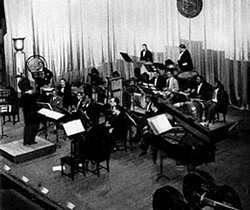
Nicolas Slonimsky conducting Ionisation in Havana
Slonimsky began writing songs and other incidental pieces, and performed as a piano soloist and vocal accompanist. In 1927 he formed the Boston Chamber Orchestra, for which he solicited music from contemporary composers. Slonimsky was a great champion of contemporary music,[3] and through his interest in performing it met Henry Cowell and Charles Ives. He conducted the world premieres of Ives' Three Places in New England in 1931 (in New York's Town Hall), Edgard Varèse's Ionisation for thirteen percussionists in 1933, and various other works.
In 1931 Slonimsky married Dorothy Adlow, art critic of The Christian Science Monitor. She was active as a critic and lectured extensively around the U.S., serving on panels and art juries. They married in Paris, with Varèse as best man. Their daughter, Electra, later edited his letters and collected works.[a]
In 1932, Slonimsky conducted a series of concerts in Havana highlighting Ives, Ruggles, Cowell, Amadeo Roldán and Alejandro García Caturla. He then traveled to Paris, Berlin and Budapest to conduct further concerts. He mentioned at the time he found conducting to be "the nearest approximation to music in motion." Thanks to the popularity of these tours, he was invited to conduct five concerts in the Hollywood Bowl in the summer of 1933. These were controversial and received mixed critical reviews.
Writings and musical criticism[edit]
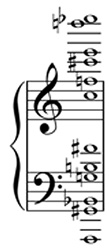
"Grandmother chord" first used by Nicolas Slonimsky
Throughout his life, Slonimsky wrote extensively for periodicals and newspapers, produced program and liner notes, and contributed to numerous reference works. He described himself as a "diaskeuast" (from Greek διασκευαστ?ς), a "reviser or interpolator". When his conducting career slowed, he spent more time writing about music. He produced the chronology Music Since 1900, and later after travelling in Latin America, produced the first thorough coverage in English, Music of Latin America. In 1947 he published the Thesaurus of Scales and Melodic Patterns, which would later become one of his most influential works as a sourcebook for composers and performers. It influenced many jazz musicians and composers, including Allan Holdsworth, John Coltrane, Frank Zappa and Paul Grabowsky, and remained in print 60 years later, but was largely ignored for years after its publication. Quincy Jones said in a February 2018 interview: "Every time I used to see Coltrane he'd have Nicolas Slonimsky's book."[4]
Two books for children followed, The Road to Music and A Thing or Two About Music, with jokes, anecdotes and puzzles. Then in 1953, Slonimsky brought out the Lexicon of Musical Invective ("Critical Assaults on Composers since Beethoven's Time"), a collection of hilariously scathing, insulting, vituperative, and enraged contemporary critiques of musical greats in their time. In 1958, he became editor of Baker's Biographical Dictionary of Musicians, developing a reputation for factual accuracy,[5] and remained its head editor until 1992.
Later life and work[edit]
In 1964 Slonimsky's wife died, and he moved to Los Angeles. He taught at UCLA for three years, and lectured and spoke about music, introducing himself to classes by spelling out his name: "Slonimsky. S-L-O as in slow, N-I-M as in nimble, S-K-Y as in sky." He possessed a sly sense of humor, and was a regular guest on radio and television programs, including Johnny Carson's Tonight Show. New York public television station WNET filmed an interview with him for the "Aging" segment of the PBS Series The Mind.
He became a friend of avant-garde composer and rock guitarist Frank Zappa, and performed some of his own compositions at a Zappa concert in Santa Monica, California, in 1981. He named his cat Grody-to-the-Max after learning the phrase from Zappa's daughter Moon Zappa.[1][3]
Slonimsky wrote the Lectionary of Music as a "reading dictionary," as he called it. Then in 1988, he published his autobiography, Perfect Pitch, filled with anecdotes about musical figures of the 20th century, including his mentors and colleagues.
For his 98th birthday, he visited St. Petersburg to participate in a music festival. A documentary of his life including video of this visit, A Touch of Genius, was broadcast by Film America on his 100th birthday and is available on the web.[6] He died in Los Angeles in 1995, at the age of 101, 4 years after the Dissolution of the Soviet Union.[7]
Compositions]
Piano[]
• Minitudes
• Variations on a Kindergarten Tune
• Yellowstone Park Suite
• Russian Nocturne
• Two Etudes
• Silhouettes Iberiennes
• Russian Prelude
• Modinha
• Variations on a Brazilian Tune (My Toy Balloon)
• Studies in Black and White
Chamber music[
• Muss Perpetuo
• Suite (?????)
• Piccolo Divertimento
• Quaquaversal Suite
Commercial and satire
• Five Advertising Songs
• Gravestones at Hancock, New Hampshire (1945)
• A Very Great Musician
• I Owe a Debt to A Monkey (A Humorous Encore Song)
Books and other writings[edit]
Books[
• Music Since 1900 (1937)[b]
? Supplement to Music since 1900 (1986)[c]
• Music of Latin America (1945)[d]
• Thesaurus of Scales and Melodic Patterns (1947)[e]
• The Road to Music New York (1947)[f]
• A Thing or Two about Music (1948)[g]
• Lexicon of Musical Invective (1953)[h]
• Baker's Biographical Dictionary of Musicians (1958).[i]
• The Concise Baker's Biographical Dictionary of Musicians (1987)[j]
• Perfect Pitch (1988)[1]
• Lectionary of Music (1989)[k]
Collected writings[edit]
• Nicolas Slonimsky: The First Hundred Years (1994)[l]
• The Great Composers and Their Works (Reissued as The Listener's Companion) (2000)[m]
• Nicolas Slonimsky: Writings on Music (2004)[n]
• Dear Dorothy - Letters from Nicolas Slonimsky to Dorothy Adlow (2012)[o]
Notes]
a ^ Some of his letters, books, photos, sheet music and recordings are maintained at slonimsky.net.
b ^ First published 1937 by Coleman-Ross. Republished in 2001 by Schirmer Reference, New York.
c ^ Charles Scribner's Sons, New York.
d ^ First published 1945 by Thomas Y. Crowell. Republished in 1972 by Da Capo Press, New York.
e ^ Coleman-Ross. Republished in 1975 by Music Sales, New York.
f ^ Dodd, Mead. Republished in 1966.
g ^ New York: Allen, Towne & Heath. Reprinted in 200 as Slonimsky's Book of Musical Anecdotes, Routledge.
h ^ Coleman-Ross. Republished in 2000 by W. W. Norton.
i ^ G. Schirmer. Republished in 2000 by Schirmer Books.
j ^ New York by Schirmer Books.
k ^ McGraw-Hill. Republished in 1990 by Anchor Books.
l ^ Ed. Richard Kostelanetz. New York: Schirmer Books.
m ^ Ed. Electra Slonimsky Yourke, 2 vols. Schirmer Books, New York.
n ^ Ed. Electra Slonimsky Yourke, 4 vols. Routledge, New York.
o ^ Ed. Electra Slonimsky Yourke, University of Rochester Press.